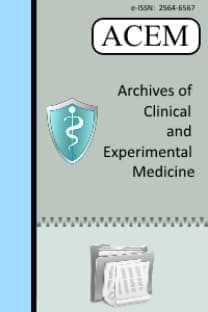Erken çocukluk çağında epileptik olmayan paroksismal olaylar ve EEG’nin rolü: Tek merkez deneyimi
paroksismal, elektroensefalografi, çocuk
Non-epileptic paroxysmal events in early childhood and role of EEG: A single center experience
paroxysmal, electroencephalography, children,
___
- 16. Facini C, Spagnoli C, Pisani F. Epileptic and non-epileptic paroxysmal motor phenomena in newborns. J Matern Fetal Neonatal Med. 2016;26:1-8.
- 15. Nechay A, Ross LM, Stephenson JB, O’Regan M. Gratification disorder (“infantile masturbation”): a review. Arch Dis Child. 2004;89:225-6.
- 14. Wolf DS, Singer HS. Pediatric movement disorders: an update. Curr Opin Neurol. 2008;21:491-6.
- 13. Marcelli V, Russo A, Cristiano E, Tessitore A. Benign paroxysmal vertigo of childhood: A 10-year observational follow-up. Cephalalgia. 2015;35:538-44.
- 12. Mason TB 2nd, Pack AI. Sleep terrors in childhood. J Pediatr. 2005;147:388-92.
- 11. Zehetner AA, Orr N, Buckmaster A, Williams K, Wheeler DM. Iron supplementation for breath-holding attacks in children. Cochrane Database Syst Rev. 2010;5:1578–605.
- 10. Abbaskhanian A, Ehteshami S, Sajjadi S, Rezai MS. Effects of Piracetam on Pediatric Breath Holding Spells: A Randomized Double Blind Controlled Trial. Iran J Child Neurol. 2012;6:9-15.
- 9. Tomoum H, Habeeb N, Elagouza I, Mobarez H. Paediatric breath-holding spells are associated with autonomic dysfunction and iron deficiency may play a role. Acta Paediatr. 2018;107:653-57.
- 8. Patel H, Scott E, Dunn D, Garg B. Nonepileptic seizures in children. Epilepsia. 2007;48:2086–92.
- 7. Kotagal P, Costa M, Wyllie E, Wolgamuth B. Paroxysmal nonepileptic events in children and adolescents. Pediatrics. 2002;110:e46.
- 6. Peter R. Dallman. B, Iron deficiency anemia: A Synthesis of current scientific knowledge and U.S. recommendations for prevention and treatment. In: Earl R, Woteki CE, editors. Iron Deficiency Anemia: Recommended Guidelines for the Prevention, Detection, and Management Among U.S. Children and Women of Childbearing Age. Washington (DC): National Academies Press (US);1993. pp. 57-9.
- 5. Headache Classification Committee of the International Headache Society (IHS). The international classification of headache disorders, 3rd edition (beta version). Cephalalgia. 2013;33:629-808.
- 4. Tatlı B, Güler S. Non-epileptic paroxysmal events in childhood. Turk Pediatri Ars. 2017;52:59-65.
- 3. Sankhyan N. Non-epileptic paroxysmal events mimicking seizures. Indian J Pediatr. 2014;81:898-902.
- 2. Paolicchi JM. The spectrum of nonepileptic events in children. Epilepsia. 2002;43:60-4.
- 1. Cuvellier JC, Lepine A. Childhood periodic syndromes. Pediatr Neurol. 2010;42:1-11.
- ISSN: 2564-6567
- Yayın Aralığı: 3
- Başlangıç: 2016
- Yayıncı: -
Posttravmatik pulmoner psödokist: İki olgu sunumu
ELİF SİNEM İPLİK, Resul KAHRAMAN, BARIŞ ERTUĞRUL, Gonca CANDAN, Arzu ERGEN, BEDİA ÇAKMAKOĞLU
Ganime Çoban, Ebru Akay, Kemal Deniz, İmdat Yüce, Süleyman Balkanlı
Tekrarlayan auriküler hematom: Bir olgu sunumu
ERDAL TEKİN, Yunus AĞAR, FATMA KESMEZ CAN
Elif Sinem İPLİK, Resul KAHRAMAN, Barış ERTUĞRUL, Gonca CANDAN, Arzu ERGEN, Bedia ÇAKMAKOĞLU
Vandetanib’e bağlı gelişen fotoallerjik dermatit: Bir olgu sunumu
Gurbet ACAR YÜCE, İsa AN, Mustafa ESEN, Nadiye AKDENİZ
Yeliz AKTÜRK, Serra ÖZBAL GÜNEŞ
ONUR KAYGISIZ, Gökhun ÖZMERDİVEN, Kadir Ömür GÜNSEREN, HAKAN KILIÇARSLAN
Hakan EMİRKADI, Hüseyin ŞEN, GÜNER DAĞLI, BULAT AYTEK ŞIK, Yaşam Kemal AKPAK
Mikail ÇAKIR, Doğan YILDIRIM, Ahmet KOCAKUŞAK, Okan Murat AKTÜRK, Leyla TİGREL
